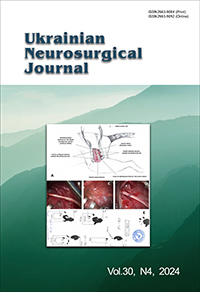Evaluation of the structures of the optic nerve and chiasm in patients with skull base tumors using high-resolution MRI
DOI:
https://doi.org/10.25305/unj.310254Keywords:
chiasmal-sellar region tumors, high-resolution MRI, compressive optic neuropathy, optic nerve atrophyAbstract
Objective: To investigate the effectiveness of radiological methods for diagnosing optic nerve and chiasm atrophy in compressive optic neuropathy caused by tumors of the chiasmal-sellar region (CSR).
Material and methods: The diagnostic and treatment outcomes of 50 patients (100 eyes) with CSR tumors were analyzed. These patients were treated at the A.P. Romodanov Institute of Neurosurgery of the National Academy of Medical Sciences of Ukraine from 2021 to 2023. The study group of patients (50 patients) was divided into two subgroups: Group I – restoration of visual functions (26 patients, 52%, 52 eyes); Group II – no restoration of visual functions (24 patients, 48%, 48 eyes). Clinical-neurological, ophthalmological, and otoneurological examinations were performed. MRI of the brain was conducted on all patients using high-field scanners (1.5 and 3.0 Tesla), and measurements of the optic nerve (ON) diameter in the intraorbital and intracranial parts, as well as the height and width of the chiasm.
Results: The morphometric parameters of the ON diameter in the intraorbital part and the height of the chiasm did not significantly differ between the studied groups (p>0.05). The morphometric parameters of Group I did not differ from the control group (p>0.05). In Group II the average diameter of the intracranial part of the ON (2.31±0.26 mm) and the average width of the chiasm (11.39±0.31 mm) were statistically significantly different from the control group values: 2.97±0.2 mm and 13.69±0.57 mm, respectively, p<0.05. Despite significant variability in individual characteristics, the parameters of the intracranial part of the ON ≤ 2.31 mm and the chiasm width of ≤ 11.39 mm indicate irreversible atrophic changes and can be used to predict ophthalmological outcomes in patients with CSR tumors.
Conclusions: Measuring the thickness of the chiasm and the diameter of the intracranial part of the optic nerve using high-resolution MRI is a convenient and effective method for diagnosing optic nerve atrophy (ONA) and predicting ophthalmological outcomes after decompression of the optochiasmal complex.
References
1. Rhoton AL Jr. The sellar region. Neurosurgery. 2002 Oct;51(4 Suppl):S335-74. [CrossRef] [PubMed]
2. Danesh-Meyer HV, Yoon JJ, Lawlor M, Savino PJ. Visual loss and recovery in chiasmal compression. Prog Retin Eye Res. 2019 Nov;73:100765. [CrossRef] [PubMed]
3. Gupta M, Ireland AC, Bordoni B. Neuroanatomy, Visual Pathway. 2022 Dec 19. In: StatPearls [Internet]. Treasure Island (FL): StatPearls Publishing; 2024 Jan-. [PubMed]
4. Kiernan JA, Barr ML. Barr's the human nervous system: an anatomical viewpoint. Lippincott Williams & Wilkins; 2014.
5. Karim S, Clark RA, Poukens V, Demer JL. Demonstration of systematic variation in human intraorbital optic nerve size by quantitative magnetic resonance imaging and histology. Invest Ophthalmol Vis Sci. 2004 Apr;45(4):1047-51. [CrossRef] [PubMed]
6. Mncube SS, Goodier MD. Normal measurements of the optic nerve, optic nerve sheath and optic chiasm in the adult population. SA J Radiol. 2019 Nov 5;23(1):1772. [CrossRef] [PubMed] [PubMed Central]
7. Prairie ML, Gencturk M, McClelland CM, Marka NA, Jiang Z, Folkertsma M, Lee MS. Establishing Optic Nerve Diameter Threshold Sensitive and Specific for Optic Atrophy Diagnosis. Clin Neuroradiol. 2024 Jun;34(2):373-378. [CrossRef] [PubMed]
8. Zhao B, Torun N, Elsayed M, Cheng AD, Brook A, Chang YM, Bhadelia RA. Diagnostic Utility of Optic Nerve Measurements with MRI in Patients with Optic Nerve Atrophy. AJNR Am J Neuroradiol. 2019 Mar;40(3):558-561. [CrossRef] [PubMed] [PubMed Central]
9. Polat SÖ, Öksüzler FY, Öksüzler M, Uygur AG, Yücel AH. The determination of the pituitary gland, optic chiasm, and intercavernous distance measurements in healthy subjects according to age and gender. Folia Morphol (Warsz). 2020;79(1):28-35. [CrossRef] [PubMed]
10. Juenger V, Cooper G, Chien C, Chikermane M, Oertel FC, Zimmermann H, Ruprecht K, Jarius S, Siebert N, Kuchling J, Papadopoulou A, Asseyer S, Bellmann-Strobl J, Paul F, Brandt AU, Scheel M. Optic chiasm measurements may be useful markers of anterior optic pathway degeneration in neuromyelitis optica spectrum disorders. Eur Radiol. 2020 Sep;30(9):5048-5058. [CrossRef] [PubMed] [PubMed Central]
11. Parravano JG, Toledo A, Kucharczyk W. Dimensions of the optic nerves, chiasm, and tracts: MR quantitative comparison between patients with optic atrophy and normals. J Comput Assist Tomogr. 1993 Sep-Oct;17(5):688-90. [CrossRef] [PubMed]
Downloads
Published
How to Cite
Issue
Section
License
Copyright (c) 2024 Ekaterina S. Egorova, Valeriia V. Musulevska, Mykola O. Guk, Oksana Y. Skobska

This work is licensed under a Creative Commons Attribution 4.0 International License.
Ukrainian Neurosurgical Journal abides by the CREATIVE COMMONS copyright rights and permissions for open access journals.
Authors, who are published in this Journal, agree to the following conditions:
1. The authors reserve the right to authorship of the work and pass the first publication right of this work to the Journal under the terms of Creative Commons Attribution License, which allows others to freely distribute the published research with the obligatory reference to the authors of the original work and the first publication of the work in this Journal.
2. The authors have the right to conclude separate supplement agreements that relate to non-exclusive work distribution in the form of which it has been published by the Journal (for example, to upload the work to the online storage of the Journal or publish it as part of a monograph), provided that the reference to the first publication of the work in this Journal is included.









